In today’s working-from-home environment, many of us have had to change the ways that we game. Board gaming by its very nature is a social enterprise and we’ve all had to adapt. From gaming over Zoom to frequenting online board game sites such as Yucata or Boardgame Arena, we’re all making do. Due to the social constrictions placed upon us by the current situation, solitaire gaming is seeing a rise in popularity. For me, I’ve found that while I have less opportunity to play games with my friends, I have more time to play games with my wife.
Despite the way COVID-19 has changed our world, my wife and I now find ourselves in a fortunate situation. We both work from home and our son’s daycare is open. During the day, even though we’re both working, we’re together and benefit from regular breaks. So, board games are back on the menu, albeit very specific types of board games.
When we first began trying to incorporate board games into our daily work-from-home diet, we tried breaking out the games that we’d normally play with our game groups: Kanban: Automotive Revolution, Madeira, and Snowdonia, for example. But we found that these weren’t working for us. Work constantly pulled us away from the table and when we returned, it was often difficult to remember who was doing what when we last left off.
What we realized we needed were games that, by their very nature, kept track of all of that themselves. These games could, theoretically, be left in their present game state, sealed away in a vault for hundreds of years, and the archaeologists of the future would be able to figure out which person goes next and which phase the game is in with just the briefest of glances. Games featuring a time track.
A time track, for those unfamiliar with the concept, is a game mechanic whereby the person who is furthest behind will always be the next person to take their turn. Thematically, more time has elapsed for the people furthest ahead. The mechanic is a bit of a misnomer, though, because this determination of turn order isn’t always associated with the passage of time as you’ll see from some of the games on this list, so I’ll call this type of mechanic “trackflow work order”. Every game on this list features this mechanic because it is perfect for keeping track of what’s going on and who’s up next.
Here I present to you, in no particular order, my Top 6 Perfectly Pausable Games.
Patchwork/Patchwork Express
While Patchwork wasn’t the first game to ever use a time track, it is arguably the game where the time track mechanic REALLY caught on. The idea of Patchwork is that two players are going head to head to produce the highest scoring patchwork quilt using a bunch of differently shaped polyomino tiles. In between the players is the time track and the tiles are arranged in a circle around it. On a player’s turn, they will have the opportunity to purchase a tile from this display and add it to their player board. The price of this purchase is paid in some combination of buttons and time. Buttons are the money used to pay for the tiles and time is the currency used to add them to your quilt.
Patchwork is an efficiency puzzle that tasks the players with figuring out how to balance their progress along the time track, their acquisition of buttons, and actually fitting the tiles onto their 9×9 player board. If you reach the center of the time track board, your game is over. If you move past your opponent on this board, it becomes their turn. If you don’t have buttons, you can’t buy tiles. And if you’re not clever with the spatial aspect of your player board, you might find yourself staring at tiles that you can’t purchase because they can’t fit. And if you can’t buy a tile then you’ll get shunted up the time track to the space beyond your opponent, getting buttons for each space moved.

One of Uwe Rosenberg’s most popular designs, Patchwork is a very clever game and an excellent introduction to the trackflow work order mechanic. So clever, in fact, that it was an official recommendation for the coveted Spiel des Jahres in 2015. Patchwork Express plays exactly the same way, but contains chunkier pieces, easier access to buttons, smaller player boards, and is fine-tuned to play much more rapidly than its namesake.
Check out our review of Patchwork to find out more about this amazing game!
Nova Luna
Nova Luna, another Uwe Rosenburg creation, also uses a time track, although in a less thematic way than Patchwork does. In Patchwork, the passage of time represents the time it would take a person to sew a patch into their quilt or to go out and earn the buttons they need. In Nova Luna, it represents the moon going through different phases: a theme which has absolutely no tie-ins to the game play at all and serves as little more than a method for keeping track of turn order. That’s not to say it isn’t a great game, though. After all, it was nominated for the Spiel des Jahres in 2020.
Nova Luna is a tile laying game. On a player’s turn, they will draft a tile from a circular display of available tiles along the outer edge of a wheel and then add this tile to their tableau. Then their player marker moves a certain number of spaces around the inner edge of the wheel depending on the tile they just drafted. If their marker is still the furthest behind when they’re done, they get to go again. Otherwise the person furthest behind goes next. I just want to reiterate this here and let it be understood that this is exactly the way turn order will work for every other game on this list.
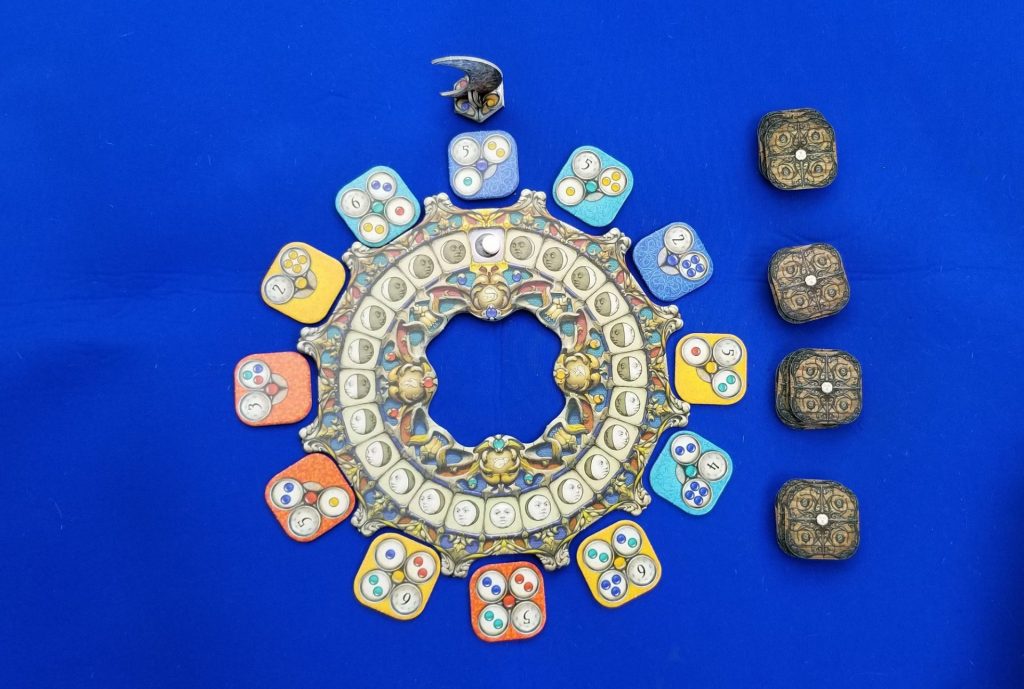
Each tile in Nova Luna has a certain color and contains some iconography that shows the criteria that need to exist in order for that tile to score. For instance, a tile might be orange with a red circle and a blue circle printed on its face. This means that the tile must be bordered by one blue tile and one red tile in order for it to score and it provides its own color, orange, to neighboring tiles to help those tiles score. And by ‘score’ I mean ‘place one of your tokens upon’ because you see, unlike Patchwork, the goal of Nova Luna isn’t to get the highest score, but to put out all of your tokens before the other players.
Nova Luna holds the honor of being the only racing game on this list, but it certainly wasn’t Rosenberg’s first. If you are a fan of Uwe Rosenberg and you like racing games, then you’ll like what he’s been up to for the past few years. Reykholt, Spring Meadow, Robin of Locksley, Nova Luna, Fairy Trails, and New York Zoo: all of these are races to the end. With Sagani and Hallertau on the horizon, though, it looks like his string of racing games is coming to an end. Will he return to revisit the genre? Will Nova Luna be the last time he ever experiments with a time track? I guess we’ll see.
Check out our review of Nova Luna for more information about this stellar title.
High Rise
In Gil Hova’s High Rise, the players are taking on the roles of moguls trying to build the tallest and highest scoring skyscrapers in the city. The city is divided into different sectors and each sector is a conglomeration of various action spaces where players acquire the building materials needed to construct the skyscrapers, pick up various cards that will give them unique abilities (like being able to draw extra floor tiles, the building blocks of the skyscrapers, from the bag or add extra floors to their constructions for even more points), and utilize the actions needed for them to actually build anything.
Each skyscraper built earns points based on its height but may be worth additional points during the end of round scoring in which each sector is considered to determine which player has the highest building there. But all of this maneuvering and construction comes at a cost in the form of corruption. Almost every action on the board provides a basic benefit, but can be amplified by taking on corruption. Corruption will cost you points at the end of the game, though, and may cost you during end of round scoring, too. So you’ll have to balance managing your empire with managing your reputation as well.
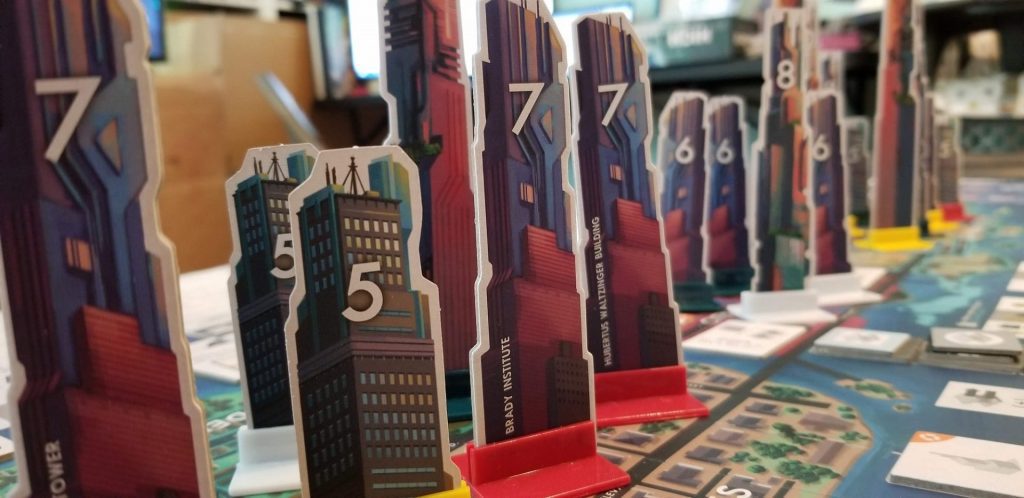
The game is played over the course of 3 rounds, called decades. At the end of the third decade, the player with the highest score wins. Thematically, each step taken as you move around the board is time progressed within that decade. The time track is used brilliantly here as it forces the players to have to weigh staying behind in order to take more actions at a time or whether to soar ahead to ensure that they get the choice pick of the upcoming actions. For instance, it’s always better to take a building action that doesn’t earn you corruption versus one that does.
High Rise isn’t for the faint of heart, though. There are a lot of tiny details to learn and keep up with initially, but after a few games it all becomes second nature and you can begin to focus on the strategy. It’s a fun game with a great table presence and a fantastic example of a Perfectly Pausable game.
Check out our review of High Rise to find out how you can make the transition from wealthy mogul to ridiculously wealthy mogul.
Glen More I and II
Glen More, and its redesign Glen More II: Chronicles, is a game about leading a 17th century Scottish clan through the trials and tribulations of building up a territory and making it profitable. It’s got all of the things you’d expect from such a game: a healthy dose of sheep, cattle, barley, and, of course, whisky. At its heart, it’s a tile laying game, but such an oversimplification does not do Matthias Cramer’s masterpiece justice. There’s so much more to Glen More than that.
In a game of Glen More, players take turns drafting from an array of face up tiles situated around the game board. As these tiles are collected (some for free and others by paying their associated costs), they are added to the players’ territories where they will cause themselves and the tiles surrounding them to activate. The activation of these tiles will cause some tiles to generate resources (which can be sold for money or used to buy or activate other tiles), some to generate point scoring opportunities, amongst other unique abilities. The ultimate goal is to score more points than your opponents and that’s where the strategy comes in.
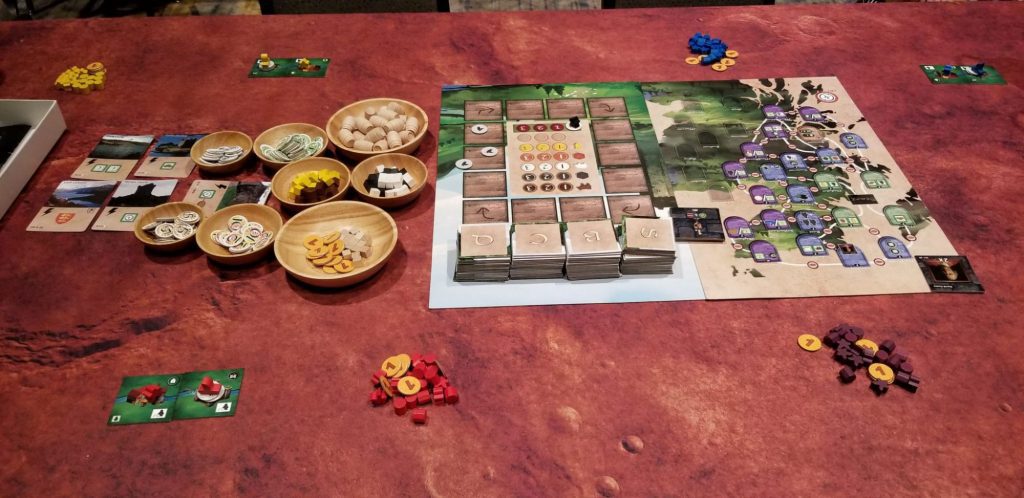
During the game, there will be multiple scorings that occur as the different stacks of tiles run out. Points in this game are awarded not by how much you have of a certain thing, but by how much of a certain thing you have when compared to the person who has the least of that thing. So it behooves players to try to have a little bit of everything versus hyperfocusing on only one or two specific things lest they unintentionally provide their opponents with high scoring opportunities.
The two games are functionally the same although Glen More II: Chronicles adds some new features by way of a Clan Board which features a lot of new actions and scoring opportunities and the titular Chronicles which are modular expansions that can be added in singly, left out entirely, or combined with other Chronicles to create varied game experiences. What hasn’t changed is the way that trackflow work order is used. In Glen More, the track isn’t used to represent the passage of time but instead acts as a way to track player order and control the timing of the scoring phases. Regardless of which Glen More you choose to play, I’m sure you’ll agree that it’s time well spent.
Check out our reviews of Glen More and Glen More II: Chronicles if you’d like more specifics about the two games, their game play, and what makes them different from one another.
Thebes
“Thebes is a game for 2 to 4 players in which players act as archaeologists in the early 1900s traveling around Europe and building up their knowledge for upcoming excavation expeditions. When they feel prepared to lead an expedition, a player will travel to an excavation site in Greece, Egypt, Crete, Mesopotamia, or Palestine and begin their dig, searching for valuable artifacts that will then score them points. Additional points can be earned if a player puts on exhibitions of these artifacts later in the game.”
The game takes place on a map that is divided into a series of cities and dig sites which are all connected via a series of lines. Surrounding this is a time track that is divided into 52 segments, each representing a week of time. During the game the players will be paying time to move between the cities to acquire cards that will provide them certain benefits such as specific knowledge about a certain site which allows them to spend their time more efficiently when they dig for artifacts there. These cards also cost the players time.

Traveling to the dig sites also costs time and performing the actual dig once you get there also costs, you guessed it, time. When a player digs, they will draw tokens from a bag and hope that the tokens they draw have an artifact printed on them. Some tokens are blank, though, and those get added back to the bag. Over the course of the game, it becomes harder and harder to gain anything worthwhile from digging at a site as a result. The number of tokens drawn and the amount of time it costs are all affected by the cards the players acquire during the game. Some cards even award you points the more of them that you collect.
And, finally, there are the exhibitions. To perform an exhibition, you must first travel to the city wherein the exhibition is being held, paying the time cost, and then show the other players that you meet the criteria shown on the card. That card is then collected and will score points at the end of the game. The game ends after a certain length of time depending on the player count. Once that happens, the player with the highest score becomes the winner.
This list wouldn’t be this list without Thebes on it, literally. Before Thebes came along at Essen Spiel in 2004, there was no such thing as trackflow work order in a board game, at least not one that was being sold in stores. Neuland, also released at Essen Spiel in 2004, featured the trackflow work order mechanic as well. Without the sales receipts to show which booth sold a copy of its game first, it’s impossible to determine which of these two games featured it first. Oddly enough, it would take another three years before Thebes would be nominated for a Spiel des Jahres.
Read our review of Thebes to find out more about this trendsetting game!
AuZtralia
“AuZtralia is a game of rail building, resource claiming and battling the great Old Ones that want to destroy humanity. In the game’s establishing narrative the Old Ones have nearly been driven from the Earth, save for a few that linger sleepily in the outback with their minions. Australia itself was abandoned centuries earlier but the times they are a-changing and the tantalising riches of the forgotten continent prove too irresistible for some.
Over the course of the game 1-4 players build railway networks from the coast into the heart of the outback, mining and farming as they go. If this was all there was, AuZtralia would be a perfectly solid game: decent but not exactly a strong contender in a crowded genre. What makes AuZtralia stand out from the crowd is that part way through the Old Ones start to awaken and cause havoc. As the game progresses it metamorphoses from an economic route-building game into a thematic war game, with players frantically battling hordes of ravaging monsters.”
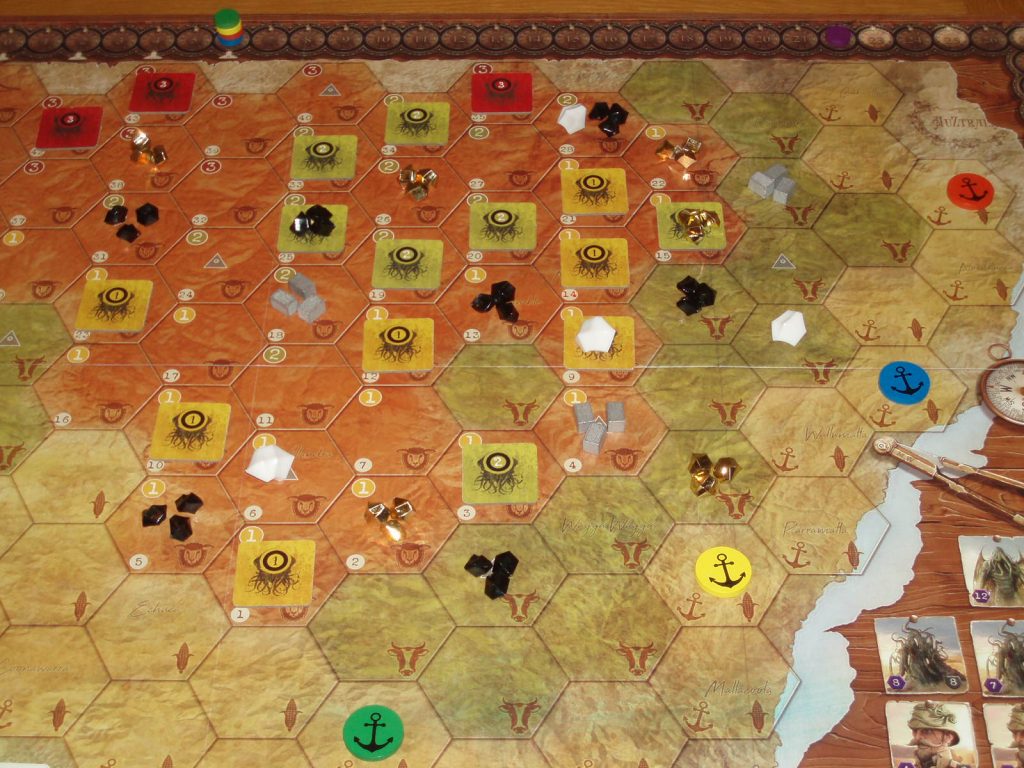
Each player has their own player board that displays several action options, contains a storage area for their collected resources, and another for their cubes which they’ll be spending to perform the actions. Each action costs a certain amount of time, which is marked on a time track, and a single cube. Taking the same action a second time will cost you not only the time, but also one gold for each cube already on the action. After paying the associated costs, another cube is added. There is an action available that lets you retrieve your cubes, but it also costs you time. And the time track in AuZtralia isn’t just used to determine turn order or to signal the end of the game, it’s also a cue for waking the Old Ones.
As Andrew Holmes stated in his excellent synopsis of the game quoted above, what begins as a placid game about railroad building, mining, and farming quickly turns into something else once Cthulhu’s minions arrive on the scene. They’re only interested in one thing: destruction. And they do it well. Once they appear, every time their time track marker lands on an odd number, an event is drawn and carried out on their behalf and these are typically not good for the players. As the monsters move across the map, they leave a wake of destruction in their path if left unchecked, but the players have the ability to fight back. If a player manages to defeat a monster, they collect its tile from the board and this, along with several of the recruitable personality cards (people that are hired for their unique abilities), your still functioning farms, and any phosphate (one of the resources) you may have collected along the way will score you points at the end of the game. The highest score wins.
What I particularly like about the way trackflow work order functions in AuZtralia is the way that it not only keeps track of turn order, but it also acts as a sort of Doomsday Clock. The way that the Old Ones enter the game isn’t a mystery. They’ve got their own time marker and it begins on the number 22. So even as you try and jockey for position with the other players, you’re always moving inexorably towards destruction. Take too many costly actions and you’ll get there faster and won’t get to take another turn until everyone else has passed you up. Take too few costly actions and you may find yourself flush with resources, but not enough defense to fight off the monstrous threats. It’s a brilliant usage of the mechanic pitting the players not just against each other, but also the game itself.
Read our review of AuZtralia for all the juicy details!
Honorable Mentions:
Tokaido
Sometimes when you’re making a list like this, you just know that you’re going to get a lot of flack if you leave off a specific game. For me, that game is Tokaido. Aside from Patchwork, it is arguably one of the most famous and well-known games that features the trackflow work order mechanic.
In Tokaido, the players are travelers traveling the Tokaido road between Tokyo and Kytoto. As they travel down the road, they will have the opportunity to stop and visit the various attractions along the way such as shops where you can purchase souvenirs that award you set collection points, farms that earn you coin, and temples where you donate money to earn valuable end-game points. And that’s what Tokaido’s all about: earning points. At the end of the game, the person with the most points wins.
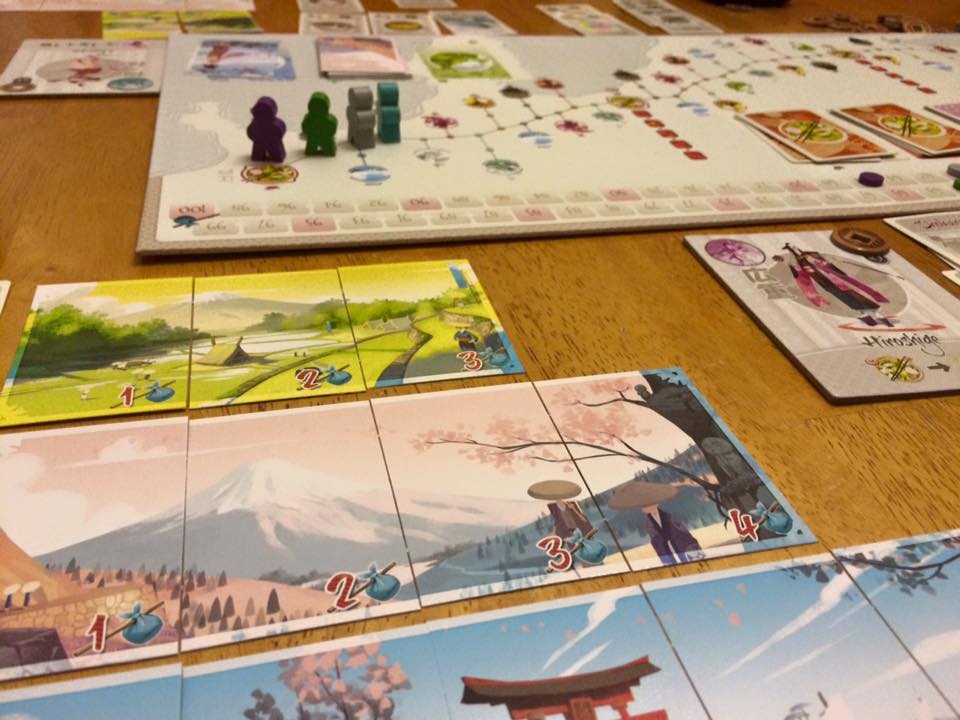
Tokaido’s beautifully rendered minimalism lends the game a sense of peace and tranquility. But this is a facade. Each player is provided with a unique character during the game’s setup and each of these characters is hoping to get different things out of the journey. The closer a player can get to achieving their character’s idea of a perfect vacation, the better off they’ll be. But these ideals sometimes (and usually do) collide and this creates just the right amount of tension that guarantees that every location along the way is going to be hard fought and hard won. It’s no wonder that Tokaido has enjoyed the success it’s had. Being designed by Antoine Bauza, the same designer of 7 Wonders, definitely doesn’t hurt either.
If you’d like a more in-depth overview, check out our review of Tokaido!
Rocky Road à la Mode
With the exception of Patchwork, all of the other games that have appeared on this list take up a good chunk of table space and even Patchwork suffers from the two-player limitation. But maybe your space is more limited and you’d like to play a Perfectly Pausable game that can accommodate your entire family. In that case, Rocky Road à la Mode might be just the game you’re looking for.
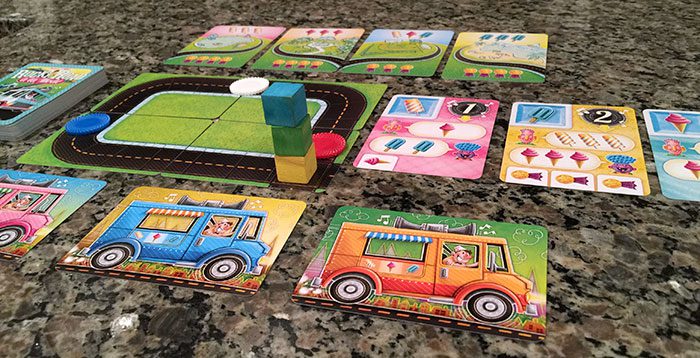
Rocky Road à la Mode is a game about building up an ice cream truck empire played on a circular time track. This track is divided into 20 segments. Players will be performing actions during the game that will move their trucks around this track a certain number of spaces: drawing cards at a 1:1 ratio (cards drawn vs. spaces moved), attracting customers (playing cards from their hand for the cost of the card), and serving customers at a cost of one movement along the track. Players will also be competing to take control of several neighborhood cards that can be claimed if they’ve served the required types of treats in the required amounts. These locations along with the completed cards from serving the customers will earn the players points and the player with the most points at the end of the game wins.
For Rocky Road à la Mode’s small size and relative simplicity, it still offers the players with a lot of interesting decisions to make. These considerations and the game’s charming artwork and approachable theme are more reasons that I felt like I should give the game a mention.
Check out our review of Rocky Road à la Mode to find out how you can build your ice cream empire!
In Closing
Trackflow work order is one of my favorite board game mechanics. I love the way that it adds a lot of depth and strategy to even the simplest of choices. More than that, though, I love the way that it takes a normal game and turns it into a Perfectly Pausable one.
My thanks to Ian Howard for suggesting the perfect title for this piece and Ashley Gariepy and Andrew Holmes for their input on a couple of titles I wasn’t intimately familiar with.


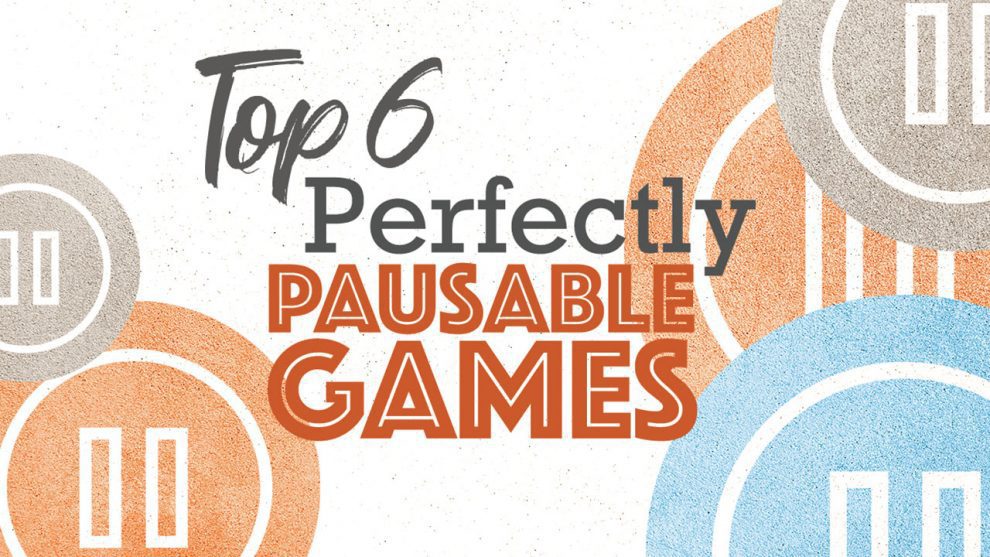

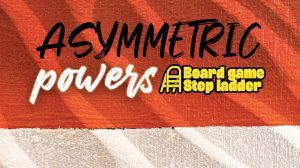

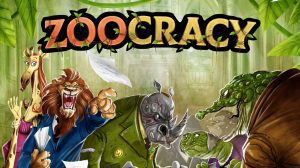




Add Comment